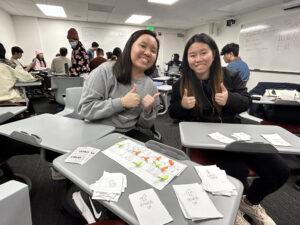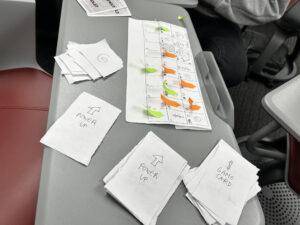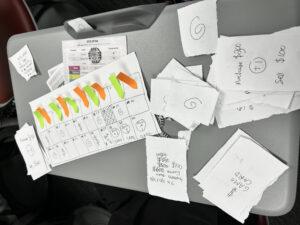Team: Amy Lo and Shimea Bridgewater
Our focus in our playtest was to test out different mechanics. Our game was based on the board game, Senet, which was created in ancient Egypt. We modded the game to fit the theme of arcade game history. However, our playtest was really to focus on what mechanics and strategies players employed that we could use in future iterations of our game.
Overall, we think this playtest offered us a clearer idea of mechanics that worked and didn’t and possible future mechanics we can introduce that would be helpful to teach what we want. When talking with Gilbert he mentioned that a great way to teach is through the system of choices and consequences which makes sense. We think with the mechanics we’re planning to add we may be on track to have a choices and consequence dynamic.
For example, do you sell your game and use your ability or wait and collect the older games so that you can then maybe earn more money in later decades as vintage games became a thing? From the game we play tested today, we liked the fact that it had strategy. We want to keep some strategy in our final game so choices that players have feel impactful and premeditated.
Playtesters: Annie & Charlotte (2)
Rules of our game
- Everyone starts with one power-up, drawn at random. The oldest player of the two starts first with the orange pieces.
- MOVE: A square can only be occupied by one piece at a time. If you can’t move forward, you must move backward (according to the same rules). If no move is possible your turn ends. You can move any of your pieces as long as you can make a valid move. Roll dice for move
- If you land on 18, you have to skip a turn.
- TRAP: If you land on 27, go back to 18 (or the first empty square before it).
- ATTACK: Landing on an opponent’s piece is an “attack”, and you exchange places; you may not land on your own pieces. Two or more consecutive opponent pieces cannot be attacked.
- BLOCKADE: Three or more consecutive opponent pieces cannot be passed; however, blockades may not turn corners (10 to 11 or 20 to 21).
- END GAME: Pieces can only bear off the final three squares by throwing the number indicated on the square. The game ends when all pieces are off the board. You may not move past 30 (for ex. if you’re on 25 and you roll a 6, this is not a valid move). A piece on 30 can be removed at the start of your turn if all of your other pieces are out of the first row.
- PURCHASES: If your piece lands on a $, you can purchase a game.
- RANDOM: If your piece lands on a swirly, you must draw a swirly which will help you get some money or lose some money ):
- SELLS: On your turn, you can sell a game for $.
- WINNING THE GAME: A player wins the game if they have the most points, which are obtained by purchasing games.
Observations Made
- Players showed some confusion with the rules
- Heard lots of play noises because of the power ups and swirly obstacle cards
- Both players felt like there was no reward for getting their game pieces off the board
- No motivation to end the game
- “There’s no inherent bonus for getting my pieces off the board”
- One player compared the game to Monopoly
- Both players liked the swirlys and the events they brought forth.
- “It made me wonder what’s going to happen to my business next.” – Annie
Things We Would Like to Change
- Add a playmat for each player to keep track of their resources
- Make it a game for 4 players instead of two which includes having players only control 1 game piece instead of multiples
- Create an obvious separation of decades
- Have “Game” cards for each decade where the card holds a game from that decade
- Similarly have event spaces on the board that introduces something that actually happened in that time that had some effect on the Arcade industry (For example, the PS2 being released which would cause everyone to lose a certain amount of money to show how the development of home consoles had a negative impact on the Arcade industry)
- As players move through the decades, games they purchased from the past will lose individual value
- In regards to the “Game” cards mentioned above:
- Each card will have a game that is from the decade you pick it up in (For example, if players are currently in the 80s they may be able to purchase Donkey Kong)
- Each card also comes with an ability related to that game in an almost meta way, but in order for players to use that ability they must sell that game card and collect money (For the Donkey Kong card the ability might be that you can send a barrel behind you which would cause all other players behind you to have to go back some number of spaces)
- Important Note: Since games lose value over time, players would be encouraged to use their abilities, i.e. sell their games, sooner rather than later
- Introduce better ways for players to get paid throughout the game (Possibly every time it’s their turn, they earn some money dependent on the games the have purchased)





